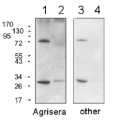1
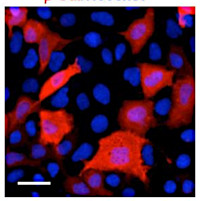
Anti-GAL | Beta galactosidase
AS20 4515 | Clonality: Monoclonal | Host: Mouse | Reactivity: Beta Galactosidase (E.coli)
- Product Info
-
Immunogen: Full length Beta galactosidase from E.coli UniProt: B7UJI9 Host: Rabbit Clonality: Polyclonal Purity: Total IgG. Protein A purified in PBS, 50 % glycerol, filter sterilized. Format: Liquid at 2 mg/ml. Quantity: 200 µg Storage: Store at -20°C, Avoid repeated freeze-thaw cycles. Please remember to spin the tubes briefly prior to opening them to avoid any losses that might occur from material adhering to the cap or sides of the tube. , Do not store this antibody below -20°C Tested applications: ELISA (ELISA), Immunofluorescence (IF), Immunoprecipitation (IP), Western blot (WB) Recommended dilution: 1: 2000 - 1: 3000 (ELISA), 1: 200 - 1: 500 (IF, IP), 1 : 1000 - 1: 2000 (WB) Expected | apparent MW: 116 kDa - Reactivity
-
Confirmed reactivity: Beta galactosidase (E.coli) and beta galactosidase tagged proteins
- Application Examples
-
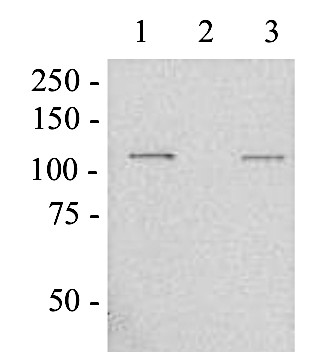
1. Purified β-galactosidase, 10 ng
2. Uninduced E. coli K12 cell extract (30 ug)
3. E.coli K12 cell extract induced by IPTG for β-galactosidase expression (30 ug)
The anti-β-galactosidase antibody was used at 1:1000 dilution in TBS-T.
Molecular mass of β-galactosidase is 116 kDa.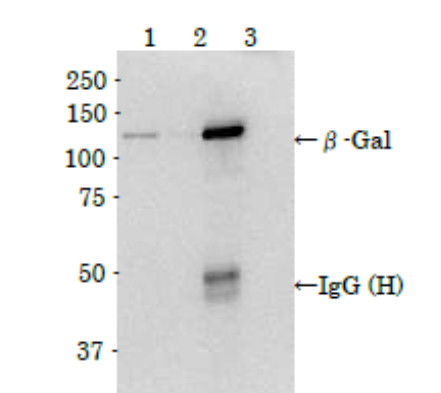
Sample: Crude extract of E. coli K12 cells induced by IPTG for β-galactosidase expression.
1. Crude cell extract
2. Supernatant of the immuno-precipitated E. coli crude extract
3. Immuno-precipitate of crude E. coli extract
The anti-β-galactosidase antibody was used at 1:500 dilution for immune-precipitation and 1:1000 for western blot. IgG (H) is heavy chain of IgG immunoglobulin. Membrane for transfer: nitrocellulose. Detection: chemiluminescent, following manufacture's recommendations.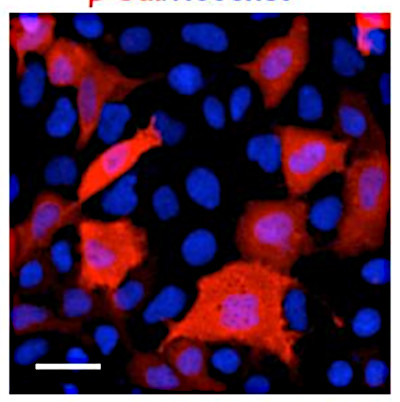
HEK293A cells were transfected with β -Gal cDNA, fixed with 4% paraformaldehyde 24 hrs later, permeabilized with methanol, and immunostained with anti-β-Gal antibody (1: 500) and Alexa 555-conjugated rabbit IgG (1:500). Chromosomal DNA was stained with Hoechst 33342. Scale bar, 50 mm. Note that the antibody reacts only in transfected cells.
- Background
-
Background: Beta-galactosidase is an exoglycosidase which hydrolyzes the β-glycosidic bond formed between agalactose and its organic moiety. It may also cleave fucosides and arabinosides but with much lower efficiency. It is an essential enzyme in the human body. Deficiencies in the protein can result ingalactosialidosis or Morquio B syndrome. In E. coli , the gene of β-galactosidase, the lacZ gene, is present as part of the inducible system lac operon which is activated in the presence of lactose when glucose level is low. It is commonly used in molecular biology as a reporter marker to monitor gene expression. It also exhibits a phenomenon called α-complementation which forms the basis for the blue/white screening of recombinant clones. This enzyme can be split in two peptides, LacZα and LacZΩ, neither of which is active by itself but when both are present together, spontaneously reassemble into a functional enzyme. This property is exploited in many cloning vectors where the presence of the lacZα gene in a plasmid can complement in trans another mutant gene encoding the LacZΩ in specific laboratory strains of E. coli . However, when DNA fragments are inserted in the vector, the production of LacZα is disrupted, the cells therefore show no β-galactosidase activity. The presence or absence of an active β-galactosidase may be detected by X-gal, which produces a characteristic blue dye when cleaved by β-galactosidase, thereby providing an easy means of distinguishing the presence or absence of cloned product in a plasmid. E. coli β-Galactosidase consists of 1,024 amino acids with molecular mass of 116 kDa and functional form is a homotetramer. - Product Citations
-
Selected references: - Protocols
- Antibody protocols
- Reviews:
-
This product doesn't have any reviews.

